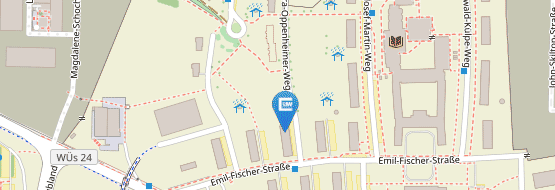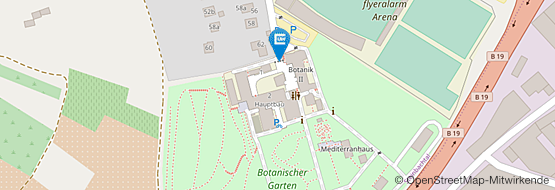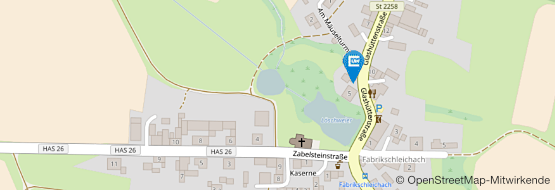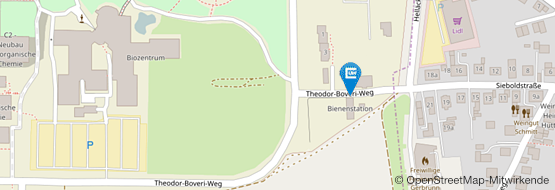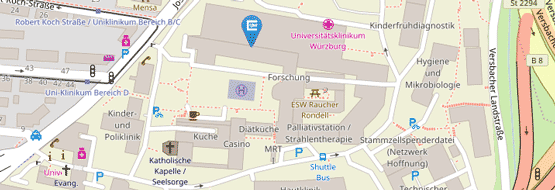Prof. Dr. Thomas Schmitt
Prof. Dr. Thomas Schmitt
Biocenter, University of Würzburg
Am Hubland

- Evolution of chemical communication in insects
- Evolution of cuticular hydrocarbon profiles in insects
- Functional aspects of chemical interactions in animals and plants
- since 2013 Professor of Animal Ecology at the University of Würzburg
- 2012 – 2013 Research Associate at the Technical University of Darmstadt
- 2010 Habilitation in Evolutionary Biology and Animal Ecology at the University of Freiburg
- 2004 – 2012 Research Associate at the University of Freiburg
- 2004 Doctoral thesis: „Communication in the Hymenoptera: Chemistry, Ecology, and Evolution“ at the University of Würzburg
- 2000 Diploma thesis: „Chemical ecology and niche specialization in West African dung beetles” at the University of Würzburg
- 1994 – 2000 Study of Biology at the University of Würzburg and SUNY Albany, NY, USA
- 1992 – 1994 Study of Chemistry at the University of Würzburg
-
(2025) Expression of Elongase‐ and Desaturase‐Encoding Genes Shapes the Cuticular Hydrocarbon Profiles of Honey Bees. Molecular Ecology 34: e17716.
- [ DOI ]
-
(2025) The Significance of Genetic Relatedness and Nest Sharing on the Worker‐Worker Similarity of Gut Bacterial Microbiome and Cuticular Hydrocarbon Profile in a Sweat Bee. Ecology and Evolution 15: e71519.
- [ DOI ]
-
(2025) Expression of Elongase- and Desaturase-Encoding Genes Shapes the Cuticular Hydrocarbon Profiles of Honey Bees. Molecular Ecology: e17716.
- [ DOI ]
-
(2024) The heat is on: reduced detection of floral scents after heatwaves in bumblebees. Proceedings of the Royal Society B: Biological Sciences 291.
- [ DOI ]
-
(2024) Highly diverse cuticular hydrocarbon profiles but no evidence for aggression towards non‐kin in the ambrosia beetle Xyleborinus saxesenii. Ecology and Evolution 14: e11274.
- [ DOI ]
-
(2024) Gut microbiota influences onset of foraging-related behavior but not physiological hallmarks of division of labor in honeybees. mBio 15: e01034-24.
- [ DOI ]
-
(2024) Deciphering the variation in cuticular hydrocarbon profiles of six European honey bee subspecies. BMC Ecology and Evolution 24: 131.
- [ DOI ]
-
(2024) Species- and sex-specific chemical composition from an internal gland-like tissue of an African frog family. Proceedings of the Royal Society B: Biological Sciences 291: 20231693.
- [ DOI ]
-
(2023) Enhancing the structural diversity between forest patches—A concept and real-world experiment to study biodiversity, multifunctionality and forest resilience across spatial scales. Global Change Biology 29: 1437-1450.
- [ DOI ]
-
(2023) Intrasexual cuticular hydrocarbon dimorphism in a wasp sheds light on hydrocarbon biosynthesis genes in Hymenoptera. Communications Biology 6: 147.
- [ DOI ]
-
(2023) Cuticular hydrocarbons of alpine bumble bees (Hymenoptera: Bombus) are species-specific, but show little evidence of elevation-related climate adaptation. Frontiers in Ecology and Evolution 11: 1082559.
- [ DOI ]
-
(2023) The Alarm Pheromone and Alarm Response of the Clonal Raider Ant. Journal of Chemical Ecology 49: 1-10.
- [ DOI ]
-
(2023) Behavioural individuality determines infection risk in clonal ant colonies. Nature Communications 14: 5233.
- [ DOI ]
-
(2023) Seasonal changes in photoperiod and temperature lead to changes in cuticular hydrocarbon profiles and affect mating success in Drosophila suzukii. Scientific Reports 13: 5649.
- [ DOI ]
-
(2023) An experimental, behavioral, and chemical analysis of food limitations in mutualistic Crematogaster ant symbionts inhabiting Macaranga host plants. Ecology and Evolution 13: e9760.
- [ DOI ]
-
(2023) Elevated ozone and carbon dioxide affects the composition of volatile organic compounds emitted by Vicia faba (L.) and visitation by European orchard bee (Osmia cornuta). PLOS ONE 18: e0283480.
- [ DOI ]
-
(2023) Evidence of cuticular hydrocarbon profile alterations by Wolbachia in females, but not males, of an aculeate parasitoid wasp. Entomologia Generalis 43: 369-377.
- [ DOI ]
-
(2023) Olfaction is essential for nest recognition in solitary Hymenoptera. Proceedings of the National Academy of Sciences 120: e2304703120.
- [ DOI ]
-
(2023) A common protocol for reliable comparison of pollen fatty acid profiles: highlighting pitfalls and proposing a methodology for ecological research. Frontiers in Ecology and Evolution 11: 1141832.
- [ DOI ]
-
(2023) Targeted treatment of injured nestmates with antimicrobial compounds in an ant society. Nature Communications 14: 8446.
- [ DOI ]
-
(2023) Pathogen evasion of social immunity. Nature Ecology & Evolution 7: 450-460.
- [ DOI ]
-
(2023) Cuticular hydrocarbon profiles in velvet ants (Hymenoptera: Mutillidae) are highly complex and do not chemically mimic their hosts. Chemoecology 33: 29-43.
- [ DOI ]
-
(2022) BETA-FOR: Erhöhung der strukturellen Diversität zwischen Waldbeständen zur Erhöhung der Multidiversität und Multifunktionalität in Produktionswäldern. Antragstext für die DFG Forschungsgruppe FOR 5375. In.
- [ DOI ]
-
(2022) Low toxicity crop fungicide (fenbuconazole) impacts reproductive male quality signals leading to a reduction of mating success in a wild solitary bee. Journal of Applied Ecology 59: 1596–1607.
- [ DOI ]
-
(2022) Chemical cues in disease recognition and their immunomodulatory role in insects. Current Opinion in Insect Science 50: 100884.
- [ DOI ]
-
(2022) Micro-climate correlations and conserved sexual dimorphism of cuticular hydrocarbons in European populations of the jewel wasp Nasonia vitripennis. Ecological Entomology 47: 38–51.
- [ DOI ]
-
(2022) Increased complexity of worker CHC profiles in Apis dorsata correlates with nesting ecology. PLOS ONE 17: 1-17.
- [ DOI ]
-
(2022) Genetic and genomic architecture of species-specific cuticular hydrocarbon variation in parasitoid wasps. Proceedings of the Royal Society B: Biological Sciences 289: 20220336.
- [ DOI ]
-
(2022) The alarm pheromone and alarm response of the clonal raider ant. Journal of Chemical Ecology.
- [ DOI ]
-
(2022) Cuticular hydrocarbon variation among Rhagoletis fruit flies (Diptera: Tephritidae): implications for premating reproductive isolation and ecological speciation. Ecological Entomology 47: 192-207.
- [ DOI ]
-
(2022) Evidence for a chemical arms race between cuckoo wasps of the genus Hedychrum and their distantly related host apoid wasps. BMC Ecology and Evolution 22: 138-.
- [ DOI ]
-
(2022) Bacterial gut microbiomes of aculeate brood parasites overlap with their aculeate hosts’, but have higher diversity and specialization. FEMS Microbiology Ecology 98: 1-12.
- [ DOI ]
-
(2021) Dinner with the roommates: trophic niche differentiation and competition in a mutualistic ant-ant association. Ecological Entomology 46: 562-572.
- [ DOI ]
-
(2021) Analysis of RNA-Seq, DNA Target Enrichment, and Sanger Nucleotide Sequence Data Resolves Deep Splits in the Phylogeny of Cuckoo Wasps (Hymenoptera: Chrysididae). Insect Systematics and Diversity 5: 1-14.
- [ DOI ]
-
(2021) Cryptic species and hidden ecological interactions of halictine bees along an elevational gradient. Ecology and Evolution 11: 7700-7712.
- [ DOI ]
-
(2021) Cuticular hydrocarbons on old museum specimens of the Spiny Mason Wasp, Odynerus spinipes, (Hymenoptera: Vespidae: Eumeninae) shed light on the distribution and on regional frequencies of distinct chemotypes. Ecological Entomology 47: 38-51.
- [ DOI ]
-
(2021) Immune challenges increase network centrality in a queenless ant. Proceedings of the Royal Society B: Biological Sciences 288: 20211456.
- [ DOI ]
-
(2021) Cuticular Hydrocarbon Profile Analyses Help Clarify the Species Identity of Dry-Mounted Cuckoo Wasps (Hymenoptera: Chrysididae), Including Type Material, and Reveal Evidence for a Cryptic Species. Insect Systematics and Diversity 5: 1-12.
- [ DOI ]
-
(2021) Cuticular hydrocarbons on old museum specimens of the spiny mason wasp, Odynerus spinipes (Hymenoptera: Vespidae: Eumeninae), shed light on the distribution and on regional frequencies of distinct chemotypes. Chemoecology 31: 311-322.
- [ DOI ]
-
(2021) Little parallelism in genomic signatures of local adaptation in two sympatric, cryptic sister species. Journal of Evolutionary Biology 34: 937-952.
- [ DOI ]
-
(2020) Do Sphecodes cuckoo bees use chemical insignificance to invade the nests of their social Lasioglossum bee hosts?. Apidologie 51: 147-162.
- [ DOI ]
-
(2020) Low Host Specialization in the Cuckoo Wasp, Parnopes grandior, Weakens Chemical Mimicry but Does Not Lead to Local Adaption. Insects 11: 136.
- [ DOI ]
-
(2020) The Attraction of the Dung Beetle Anoplotrupes stercorosus (Coleoptera: Geotrupidae) to Volatiles from Vertebrate Cadavers. Insects 11: 476.
- [ DOI ]
-
(2020) Diapause affects cuticular hydrocarbon composition and mating behavior of both sexes in Drosophila montana. Insect Science 27: 304-316.
- [ DOI ]
-
(2020) Odour-mediated group organisation and coordination in the termite raiding ant Megaponera analis (Mayr). Chemical Senses 45: 635-644.
- [ DOI ]
-
(2019) Phylogenetic analysis of cuckoo wasps (Hymenoptera: Chrysididae) reveals a partially artificial classification at the genus level and a species-rich clade of bee parasitoids: Phylogeny and host associations of cuckoo wasps. Systematic Entomology 44: 322-335.
- [ DOI ]
-
(2019) Hybrid Genome Assembly of a Neotropical Mutualistic Ant. Genome Biology and Evolution 11: 2306-2311.
- [ DOI ]
-
(2019) Strength of sexual and postmating prezygotic barriers varies between sympatric populations with different histories and species abundances. Evolution 73: 1182-1199.
- [ DOI ]
-
(2019) Habitats shape the cuticular chemical profiles of stingless bees. Chemoecology 29: 125-133.
- [ DOI ]
-
(2019) Species composition and elevational distribution of bumble bees (Hymenoptera, Apidae, Bombus Latreille) in the East Himalaya, Arunachal Pradesh, India. ZooKeys 851: 71-89.
- [ DOI ]
-
(2019) A clue on bee glue: New insight into the sources and factors driving resin intake in honeybees (Apis mellifera). PLOS ONE 14: e0210594.
- [ DOI ]
-
(2019) Influence of Mutualistic Lifestyle, Mutualistic Partner, and Climate on Cuticular Hydrocarbon Profiles in Parabiotic Ants. Journal of Chemical Ecology 45: 741-754.
- [ DOI ]
-
(2019) Cuticular hydrocarbons as potential mediators of cryptic species divergence in a mutualistic ant association. Ecology and Evolution 9: 9160-9176.
- [ DOI ]
-
(2018) Communication, Insects. In Encyclopedia of Reproduction bll 78-83.
- [ DOI ]
-
(2018) Differences in the reliance on cuticular hydrocarbons as sexual signaling and species discrimination cues in parasitoid wasps. Frontiers in Zoology 15: 22.
- [ DOI ]
-
(2018) In search of cues: dung beetle attraction and the significance of volatile composition of dung. Chemoecology 28: 145-152.
- [ DOI ]
-
(2018) Global dung webs: high trophic generalism of dung beetles along the latitudinal diversity gradient. Ecology Letters 21: 1229-1236.
- [ DOI ]
-
(2018) Covariation and phenotypic integration in chemical communication displays: biosynthetic constraints and eco-evolutionary implications. New Phytologist 220: 739-749.
- [ DOI ]
-
(2018) Destructive disinfection of infected brood prevents systemic disease spread in ant colonies. Elife 7: e32073.
- [ DOI ]
-
(2017) Volatiles Emitted by Calling Males of Burying Beetles and Ptomascopus morio (Coleoptera: Silphidae: Nicrophorinae) Are Biogenetically Related. Journal of Chemical Ecology 43: 971-977.
- [ DOI ]
-
(2017) Evolutionary History of the Hymenoptera. Current Biology 27: 1013-1018.
- [ DOI ]
-
(2017) Land use affects dung beetle communities and their ecosystem service in forests and grasslands. Agriculture, Ecosystems & Environment 243: 114-122.
- [ DOI ]
-
(2017) The database of the PREDICTS (Projecting Responses of Ecological Diversity In Changing Terrestrial Systems) project. Ecology and Evolution 7: 145-188.
- [ DOI ]
-
(2017) Covariation and phenotypic integration in chemical communication displays: biosynthetic constraints and eco-evolutionary implications. New Phytologist 220: 739-749.
- [ DOI ]
-
(2017) Saving the injured: Rescue behavior in the termite-hunting ant Megaponera analis. Science Advances 3: e1602187.
- [ DOI ]
-
(2017) Post-mating shift towards longer-chain cuticular hydrocarbons drastically reduces female attractiveness to males in a digger wasp. Journal of Insect Physiology 100: 119-127.
- [ DOI ]
-
(2017) How do cuticular hydrocarbons evolve? Physiological constraints and climatic and biotic selection pressures act on a complex functional trait. Proceedings of the Royal Society B: Biological Sciences 284: 20161727.
- [ DOI ]
-
(2017) Transcriptome and target DNA enrichment sequence data provide new insights into the phylogeny of vespid wasps (Hymenoptera: Aculeata: Vespidae). Molecular Phylogenetics and Evolution 116: 213-226.
- [ DOI ]
-
(2017) Release from prey preservation behavior via prey switch allowed diversification of cuticular hydrocarbon profiles in digger wasps: DIVERSIFICATION OF DIGGER WASP CUTICULAR PROFILES. Evolution 71: 2562-2571.
- [ DOI ]
-
(2017) Attraction of dung beetles to herbivore dung and synthetic compounds in a comparative field study. Chemoecology 27: 75-84.
- [ DOI ]
-
(2017) The evolution of a complex trait: cuticular hydrocarbons in ants evolve independent from phylogenetic constraints. Journal of Evolutionary Biology 30: 1372-1385.
- [ DOI ]
[2016]
Flaig I. C., Aguilar I., Schmitt T. & Jarau S. (2016) An unusual recruitment strategy in a mass‐recruiting stingless bee, Partamona orizabaensis. Journal of Comparative Physiology A 202: 679-690.
Diao W., Mousset M., Horsburgh G. J., Vermeulen C. J., Johannes F., van de Zande L., Ritchie M. G., Schmitt T. & Beukeboom L. W. (2016) Quantitative trait locus analysis of mating behavior and male sex pheromones in Nasonia wasps. G3 - Genes, Genomics, Genetics 6: 1549-1562.
Leonhardt S. D., Menzel F., Nehring V. & Schmitt T. (2016) Ecology and evolution of communication in social insects (invited review). Cell 164: 1277-1287.
Jansen J., Pokorny T. & Schmitt T. (2016): Disentangling the effect of insemination and ovary development on the cuticular hydrocarbon profile in the bumblebee Bombus terrestris (Hymenoptera: Apidae). Apidologie 47: 101-113.
[2015]
Wurdack M., Herbertz S., Dowling D., Kroiss J., Strohm E., Baur H., Niehuis O. & Schmitt T. (2015) Striking cuticular hydrocarbon dimorphism in the mason wasp Odynerus spinipes and its possible evolutionary cause (Hymenoptera: Chrysididae, Vespidae). Proceedings of the Royal Sociecty B, London 282: 20151777.
Strube-Bloss M. F., Brown A., Spaethe J., Schmitt T. & Rössler W. (2015) Extracting the behaviorally relevant stimulus: Unique neural representation of farnesol, a component of the recruitment pheromone of Bombus terrestris. PLoS ONE 10: e0137413. OPEN ACCESS.
Buellesbach J. & Schmitt T. (2015): The role of cuticular hydrocarbon-based chemical communication in prezygotic reproductive isolation. In Animal Communication and Cognition: Principles, Evolution and Development, ed. Wagner T. Nova Publishers, Hauppauge NY, pp. 107-119.
[2014]
Leonhardt S. D., Baumann A.-M., Wallace H. M., Brooks P. & Schmitt T. (2014) The chemistry of an unusual seed dispersal mutualism: bees use a complex set of olfactory cues to find their partner. Animal Behaviour 98: 41-51.
Büllesbach J., Greim C., Raychoudhury R. & Schmitt T. (2014) Asymmetric assortative mating behaviour reflects incomplete prezygotic isolation in the Nasonia species complex. Ethology 120: 834-843.
Jennings J. H., Etges W. J., Schmitt T. & Hoikkala A. (2014) Cuticular hydrocarbons of Drosophila montana: Geographic variation, sexual dimorphism and potential roles as pheromones. Journal of Insect Physiology 61: 16–24.
Menzel F., Orivel J., Kaltenpoth M. & Schmitt T. (2014) What makes you a potential partner? Insights from convergently evolved ant–ant symbioses. Chemoecology 24: 105-119.
[2013]
Giesbers M. C. W. G., Gerritsma S., Buellesbach J., Diao W., Pannebaker B. A., van de Zande L., Schmitt T. & Beukeboom L. W. (2013): Prezygotic isolation in the parasitoid wasp genus Nasonia. In: Speciation: Natural Processes, Genetics and Biodiversity, ed. Michalak P. Nova Publishers, Hauppauge NY, pp. 165-195.
Rödel M.-O., Brede C., Hirschfeld M., Schmitt T., Favreau P., Stöcklin R., Wunder C. & Mebs D. (2013) Chemical camouflage – a frog’s strategy to co-exist with aggressive ants. PLOS One 8(12):e81950.
Buellesbach J. M., Gadau J., Beukeboom L. W., Echinger F., Raychoudhury R., Werren J. H. & Schmitt T. (2013) Cuticular hydrocarbon divergence in the jewel wasp Nasonia: Evolutionary shifts in chemical communication channel? Journal of Evolutionary Biology 26: 2467-2478.
Menzel F., Blüthgen N., Tolasch T., Conrad J., Beifuß U., Beuerle T. & Schmitt T. (2013) Crematoenones – a novel substance class exhibited by ants functions as appeasement signal. Frontiers in Zoology 10:32.
Leonhardt S. D., Rasmussen C. & Schmitt T. (2013) Genes vs. environment: Geography and phylogenetic relationships shape the chemical profiles of stingless bees on a global scale. Proceedings of the Royal Society B, London 280:1762.
Niehaus O., Büllesbach J., Gibson, J. D., Pothmann D., Hanner C., Mutti N. S., Judson A. K., Gadau J., Ruther J. & Schmitt T. (2013) Behavioural and genetic analyses on Nasonia shed light on the evolution of sex pheromones. Nature 494: 345-348.
[2012]
Schlechter J., Schmitt T. & Peschke K. (2012) Learning individual signatures: rove beetle males discriminate unreceptive females by cuticular hydrocarbon patterns. Animal Behaviour 84: 369-376.
Menzel F. & Schmitt T. (2012) First evidence for an interspecific selection pressure on chemical recognition cues. Evolution 66: 896-904.
Butlin R., Debelle A., Kerth C, Snook R. R., Beukeboom L. W., Castillo Cajas R. F., Diao W., Maan M. M., Paolucci S., Weissing F. J., van de Zande L., Hoikkala A., Geuverink E., Jennings J., Kankare, M., Knott K. E., Tyukmaeva V. I., Zoumadakis C., Ritchie M. G., Barker D., Immonen E., Noor M., Macias C., Schmitt T. & Schilthuizen M. (2012) What do we need to know about speciation? Trends in Ecology and Evolution 27: 27-39.
[2011]
Leonhardt S.D., Form S., Blüthgen N., Schmitt T. & Feldhaar H. (2011) Genetic relatedness and chemical profiles in an unusually peaceful eusocial bee. Journal of Chemical Ecology 37: 1117-1126.
Schlechter J., Schmitt T. & Peschke K. (2011) A contact antiaphrodisiac pheromone supplied by the spermatophore in the rove beetle Aleochara curtula: mode of transfer and evolutionary significance. Naturwissenschaften 98: 855-862.
Haberer W., Schmitt T., Schreier P. & Müller J.K. (2011) Intended and unintended receivers of the male pheromones of the burying beetles Nicrophorus humator and Nicrophorus vespilloides. Entomologia Experimentalis et Applicata 140: 122-126.
Leonhardt S., Schmitt T. & Blüthgen N. (2011) Tree resin composition, collection behaviour and selective filters shape chemical profiles of tropical bees (Apidae: Meliponini). PLoS One 6(8), e23445.
Leonhardt, S.D., Wallace, H.M. & Schmitt T. (2011) The cuticular profiles of Australian stingless bees are shaped by resin of the euclypt tree Corymbia torelliana. Austral Ecology 36: 537-543.
Niehuis O., Büllesbach J., Judson A.K., Schmitt T. & Gadau J. (2011) Genetics of cuticular hydrocarbons in F2 hybrid males of Nasonia giraulti and Nasonia vitripennis. Heredity 107: 61-70.
Steiger S., Schmitt T. & Schaefer H. M. (2011) The dynamic evolution of chemical information transfer. Proceedings of the Royal Society B, London 278: 970-979.
Leonhardt S., Blüthgen N. & Schmitt T. (2011) Chemical profiles of body surfaces and nests from six Bornean stingless bee species. Journal of Chemical Ecology 37: 98-104.
[2010]
Menzel F., Woywod M., Blüthgen N. & Schmitt T. (2010) Behavioural and chemical mechanisms behind a Mediterranean ant-ant association. Ecological Entomology 35: 711-720.
Drescher J., Blüthgen N., Schmitt T., Bühler J. & Feldhaar H. (2010) Societies drifting apart? Behavioral, genetic and chemical differentiation between supercolonies in the yellow crazy ant Anaplolepis gracilipes. PlosOne 5: e13581.
Leonhardt S., Zeilhofer S., Blüthgen N. & Schmitt T. (2010) Singless bees use terpenes as olfactory cues to find resin sources. Chemical Senses 35: 593-601.
Leonhardt S., Jung L.-M., Schmitt T. & Blüthgen N. (2010) Terpenoids tame aggressors: role of chemicals in stingless bee communal nesting. Behavioral Ecology & Sociobiology 64: 1415-1523.
Menzel F., Pokorny T., Blüthgen N. & Schmitt T. (2010) Trail-sharing among tropical ants: interspecific use of trail pheromones? Ecological Entomology 35: 495-503.
Kaltenpoth M., Schmitt T., Polidori C., Koedam D. & Strohm E. (2010) Symbiotic streptomycetes in the antennae of South American Trachypus digger wasps (Hymenoptera, Carbronidae). Physiological Entomology 35: 196-200.
Raychoudhury R., Desjardins C. A., Buellesbach J., Loehlin D. W., Grillenberger B. K., Beukeboom L., Schmitt T. & Werren J. H. (2010) Behavioural and genetic characteristics of a new species of Nasonia. Heredity 104: 278-288.
The Nasonia Genome Working Group (2010) Functional and evolutionary insights from the genomes of three Nasonia species. Science327: 343-348.
[2009]
Kaltenpoth M., Schmitt T. & Strohm E. (2009) Hydrocarbons of the antennal gland secretion of female European beewolves, Philanthus triangulum (Hymenoptera: Crabronidae). Chemoecology 19: 219-225.
Menzel F., Schmitt T. & Blüthgen N. (2009) Interspecific nestmate recognition in two parabiotic ant species: acquired recognition cues and low inter-colony discrimination. Insectes Sociaux 56: 251-260.
Leonhardt S., Blüthgen N. & Schmitt T. (2009) Smelling like resin: terpenoids account for species-specific cuticular profiles in Southeast-Asian stingless bees. Insectes Sociaux 56: 157-170.
Kroiss J., Schmitt T. & Strohm E. (2009) Low level of cuticular hydrocarbons in a parasitoid of a solitary digger wasp and its potential for concealment. Entomological Science 12: 9-16.
Geiselhardt S., Schmitt T. & Peschke K. (2009) Chemical composition and pheromonal function of the defensive secretions in the subtribe Stizopina (Coleoptera, Tenebrionidae, Opatrini). Chemoecology 19: 1-6.
[2008]
Menzel F., Blüthgen N. & Schmitt T. (2008) Tropical parabiotic ants: Highly unusual cuticular substances and low interspecific discrimination. Frontiers in Zoology 5:16.
Strohm E., Herzner G., Kaltenpoth, M., Boland W., Schreier P., Geiselhardt S., Peschke K. & Schmitt T. (2008) The chemistry of the postpharyngeal gland of female European Beewolves. Journal of Chemical Ecology 34: 575-583.
Oettler J., Schmitt T., Herzner G. & Heinze J. (2008) Chemical profiles of mated and virgin queens, egg-laying intermorphs and workers of the ant Crematogaster smithii. Journal of Insect Physiology 54: 672-679.
Haberer W., Schmitt T., Peschke K., Schreier P. & Müller J. K. (2008) Ethyl 4-methyl heptanoate: a male-produced pheromone of Nicrophorus vespilloides. Journal of Chemical Ecology 34: 94-98.
Strohm E., Kroiss J., Herzner G., Laurien-Kehnen C., Boland W., Schreier P. & Schmitt T. (2008): A cuckoo in wolves’ clothing? Chemical mimicry in a specialized cuckoo wasp of the European beewolf (Hymenoptera, Chrysididae and Crabronidae). Frontiers in Zoology 5: 2.
[2007]
Herzner G., Schmitt T., Peschke K., Hilpert A. & Strohm E. (2007) Food wrapping with the postpharyngeal gland secretion by females of the European beewolf Philanthus triangulum. Journal of Chemical Ecology 33: 849-859.
Schmitt T., Herzner G., Weckerle B., Schreier P. & Strohm E. (2007) Volatiles of foraging honeybees Apis mellifera L. (Hymenoptera: Apidae) and their potential role as semiochemicals. Apidologie 38: 164-170.
[2006]
Kroiss J., Schmitt T., Schreier P., Strohm E. & Herzner G. (2006) A selfish function of a social gland? A postpharyngeal gland functions as sex pheromone reservoir in males of a solitary wasp. Journal of Chemical Ecology 32: 2763-2776.
Brandt M., Heinze J., Schmitt T. & Foitzik, S. (2006) Convergent evolution of the Dufour’s gland secretion as a propaganda substance in the slave-making ant genera Protomognathus and Harpagoxenus. Insectes Sociaux 53: 291-299.
Herzner G., Schmitt T., Schreier P. & Strohm E. (2006) Brothers smell similar: Variation in the sex pheromone of male European Beewolves and its implications for inbreeding avoidance. Biological Journal of the Linnean Society 89: 433-442.
[2005]
Böll S., Schmitt T., Burschka C., Schreier P., Schwappach P. & Herrmann J. V. (2005): Calciumtartrate crystals in the midgut of the grape leafhopper. Journal of Chemical Ecology 31: 2847-2856.
Herzner G., Schmitt T., Linsenmair K. E. & Strohm E. (2005) Prey recognition by females of the European beewolf and its potential for a sensory trap. Animal Behaviour 70: 1411-1418.
Brandt M., Heinze J., Schmitt T. & Foitzik, S. (2005) A chemical level in the coevolutionary arms race between an ant social parasite and its hosts. Journal of Evolutionary Biology 18: 576-586.
[2004]
Schmitt T., Krell F.-T. & Linsenmair K. E. (2004) Quinone mixture as attractant for necrophagous dung beetles on dead millipedes. Journal of Chemical Ecology 30: 731-740.
Endler A., Liebig J., Schmitt T., Parker J., Jones G., Schreier P. & Hölldobler B. (2004) Surface hydrocarbons of queen eggs regulate worker reproduction in a social insect. Proceedings of the National Academy of Science of the USA 101: 2945-2950.
[2003]
Herzner G., Schmitt T., Linsenmair K. E. & Strohm E. (2003) Flagellar sensilla in male and female European beewolves, Philanthus triangulum F. (Hymenoptera: Sphecidae). Entomologica Fennica 14: 237–247.
Schmitt T., Strohm E., Herzner G., Bicchi C., Krammer G., Heckel F. & Schreier P. (2003) (S)-2,3-Dihydrofarnesoic acid, a new component in cephalic glands of male European beewolves Philanthus triangulum. Journal of Chemical Ecology 29: 2469-2479.
[1999]
Schmitt T. & Lehman N. (1999) Non-unity molecular heritability demonstrated by continuous evolution in vitro. Chemistry & Biology 6: 857-869.
Krell F.-T., Schmitt T. & Linsenmair K. E. (1999) The rhinoceros beetle Cyphonistes tuberculifrons Quedenfeldt 1884 attracted by quinones (Coleoptera Scarabaeidae Dynastinae): primary olfactory attraction of a saprophagous beetle by its source of food? Tropical Zoology 12: 297-308.
[1997]
Krell F.-T. Schmitt T. & Linsenmair K. E. (1997): Diplopod defensive secretions as attractants for necrophagous scarab beetles (Diplopoda; Insecta, Coleoptera: Scarabaeidae). Entomologica Scandinavica Supplement 51: 281-285.




